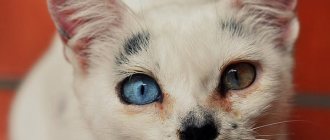Despite their cute appearance, cats are natural hunters. Nature has endowed them with sharp eyesight and the ability to see in the dark. Cats' eyes are designed so perfectly that they are almost immune to disease. According to statistics, cats suffer from eye diseases much less often than dogs. However, they also have problems. One of the main symptoms indicating a problem is redness of the eye and the area around it. What diseases are accompanied by redness? How to determine the cause and what to do when redness appears?
Possible reasons
Redness of a cat's eyes occurs for various reasons. Such problems arise due to physiological or pathological changes. An allergic reaction can trigger the appearance of redness.
You can find out what to do in this situation only after identifying the provoking factor.
Physiological reasons
The cause of hyperemia often lies in injury or exposure to irritants.
Such changes are observed in the following cases:
- Foreign body. Debris and dust entering the eye cause damage to the mucous membranes. In addition to redness, pain and tearing are noted.
- Irritation caused by soapy water, chemicals.
- Hanging fur. Such problems are observed in long-haired breeds. The hairs get on the cornea and injure it.
- Lens luxation. Develops due to injury, glaucoma, uveitis, cataracts. The iris takes on an abnormal appearance. The displacement is noticeable to the naked eye.
- Hyphema. The accumulation of blood in the anterior chamber is caused by injuries and poor blood clotting.
- Proptosis. Complete or partial loss of the eyeball is a consequence of damage to the organ of vision.
Pathological causes
The following eye diseases can cause redness:
- Blepharitis. Inflammation of the eyelid can be of an allergic or infectious nature. The eyelids become enlarged, discharge and itching are noted.
- Prolapse. With this pathology, the corners of the eyes turn red due to a change in the position of the lacrimal glands, their loss from the conjunctival sac.
- Conjunctivitis. There is thickening of the conjunctiva and profuse lacrimation.
- Tumor. Localized on the organ itself or tissues around the eyes.
- Ulceration of the cornea. Its surface layer is damaged. Associated symptoms are photophobia and pain.
- Dry keratoconjunctivitis. Develops in older cats. Little tear fluid is produced, and the cornea dries out. A burning sensation appears, bright light leads to irritation.
- Glaucoma. Increased intraocular pressure provokes destruction of the eye structure. The pupils dilate, the cornea becomes cloudy. In the absence of therapy, the optic nerve atrophies, resulting in complete loss of vision.
Infectious pathologies
Red eyes are often caused by infection:
- Mycoplasmosis . A severe pathology of an infectious nature, often leading to the development of pneumonia. In addition to the conjunctiva, joints, kidneys, and genitals are sometimes affected. Cough, nasal discharge, hyperthermia, inflammation of the conjunctiva should alert you.
- Chlamydia . The disease affects the organs of vision, respiratory tract, and gastrointestinal tract. In the conjunctive form of the disease, redness of the eyes is noted. There is a risk of vision loss.
- Calcivirosis . Affects the conjunctiva, mucous membranes of the mouth, nose, and joints. Pathology often leads to the death of the animal.
What to do, the kitten’s eyes are festering. How to treat? Part 2
An advanced form of any disease that is accompanied by redness of the eyeballs can cause complete blindness in the cat.
Common causes of redness include:
- Blepharitis. With this disease, inflammation of the eyelid occurs. Most often occurs under the influence of allergens or irritants. In this case, the eyelid swells greatly and the cat's eye becomes red. There is no need to undergo major surgery. For treatment, antifungal drugs, antibiotic drops and therapeutic procedures are used to help get rid of the root cause.
- Gland prolapse. A red hematoma appears in the white, similar in appearance to a cherry. It is removed surgically.
- Lens luxation. It can be congenital or acquired. The pathology is characterized by displacement of the lens relative to its normal position. The iris becomes abnormal in appearance. A surgical approach is used for treatment.
- Glaucoma. The disease occurs under the influence of high intraocular pressure. It is considered one of the most common causes of redness of the whites of the eyes. The disease can also be identified by swelling of the eyelid and enlarged blood vessels. In this case, the pupils stop responding to light stimulation. There is no cure for glaucoma. With it, it is important to find and eliminate the main cause of its occurrence.
- Hyphema. With pathology, blood enters the anterior chamber of the eyeball. This causes a change in the quality of the animal's vision. Therapy consists of getting rid of the main cause. The veterinarian prescribes anti-inflammatory drops that help dilate the pupils.
- Conjunctivitis. The reason is inflammation of the conjunctiva. The main symptoms are mucus secretion. It occurs quite often in cats. Treated with antibacterial drops.
- Tumor of the eye or eyelid. It occurs not only in adults, but also in kittens. They fight it surgically; in advanced forms, radiotherapy is used.
- Foreign body. It can get both inside the organ of vision and on its surface. The cats' eyes begin to water. The object can be examined without the use of special instruments. It is removed, after which antibiotic drops are used.
- Proptosis. Occurs due to injuries to the mucous membrane. The eyeball begins to protrude from the socket. The defect can be corrected through surgery. In rare cases, complete removal of the organ is required.
- Uveitis. It is a common disease. It causes inflammation of the iris. Accompanied by photophobia, a change in the color of the iris to red, lacrimation, swelling and clouding of the cornea. Treated with anti-inflammatory drugs.
- Corneal ulcer. Obvious signs of the disease may not be noticed. Symptoms include squinting, redness and watery eyes. First, antibiotic drops are used. If this method does not help, then resort to surgery.
- Keratitis. It is characterized by damage to the cornea, clouding of the lens and purulent discharge. For treatment, you should regularly wash your eyes and instill antibiotic drops.
- Keratoconjunctivitis. The mucous membrane lacks tear secretions. The problem can be corrected by using drops created to increase secretion from the organ of vision.
Sometimes it is impossible to take an animal to a doctor's appointment. In such cases, it is recommended to use a special collar that will prevent the cat from touching its eyes with its paws. In this case, purulent discharge must be removed with a cotton pad, and the organs of vision must be rinsed with clean water.
Are your kitten's eyes infected? This happens, it’s a disease, see how to treat it and what to do if a kitten is infected...
Before using any medications, especially without prior consultation with a veterinarian, you need to clarify as much as possible the reasons why the disease occurred. In most cases, it is more convenient to determine the cause by reducing the spectrum of symptoms.
All causes of discharge from the eyes can be divided into:
- Viral – contact with a sick animal quickly infects a healthy one.
- Infectious - the disease occurs against the background of eye damage by microbes, fungi, and bacteria.
- Congenital - ailments that arise as a result of disturbances in intrauterine development.
- Post-traumatic – a disease that occurs after an injury or as a result of constant trauma.
According to the method of development, diseases can be divided into:
- Local - affects only the eyes and communicating mucous membranes.
- Extensive - have a negative effect on the entire body.
It is important to understand that purulent discharge from the eyes can signal ailments that develop secretly and have a detrimental effect on the immune system.
The formation of pus, in itself, is not dangerous if the discharge is yellowish or white. In this case, the pus is sterile and is a product of the processing of dead tissue.
If the pus has a strong odor, green, brown or other unnatural color, this indicates re-infection and severe inflammation, which is often accompanied by fever.
Red eyes is a flexible and multifaceted concept. If your kitten's eyelids are red, the problem may be:
- Blockage or inflammation of the nasolacrimal ducts.
- Swelling of the mucous membranes - due to fatigue, fever, overexcitation, stress, overheating, poisoning and for many other reasons.
- Inflammation of the third eyelid - leads to swelling and bulging of the mucous membrane from under the lower eyelid, usually in the corner of the eye.
Red whites of the eyes indicate enlargement or damage to small blood vessels. This usually happens after overheating or severe stress. Practice shows that redness of the whites of the eyes is a temporary phenomenon that goes away without external intervention.
If the whites of the eyes and the iris are literally bloodshot, this indicates a traumatic brain injury or increased intracranial pressure due to another reason.
The most common cause of discharge, as a result of which the eyelids stick together and the eyes do not open, is conjunctivitis.
Conjunctivitis is divided into:
- Infectious - occurs against the background of irritation of the mucous membrane, due to dust, chapping and other external factors.
- Viral is a symptom of a contagious disease that develops covertly or acutely.
- Allergic – occurs against the background of constant stimulation of the immune system.
- Chronic - can occur against the background of constant drying of the eyes, improper functioning of the nasolacrimal ducts, ulcerations of the cornea and for other reasons.
Regardless of the cause, conjunctivitis is accompanied by purulent discharge from the eyes. When a kitten sleeps, the mucous membranes of the eyes are actively cleansed, which leads to copious discharge of pus. The pus dries quickly, sticks together eyelashes, hairs and eyelids, which makes it difficult for the kitten to open its eyes after waking up.
If a kitten has snot (runny nose, rhinitis), he constantly sneezes, and his eyes are watery, there are three possible reasons:
- Allergy.
- Cold.
- A viral disease that leads to irritation of the mucous membranes. Rhinotracheitis is possible in small, unvaccinated kittens.
We suggest you read: What should be in a large cage of a decorative rat || Cages for pet rats
Alarming symptoms caused by allergies disappear without external intervention when the allergen is eliminated. Most often, an allergic reaction occurs after a sudden change in diet or the purchase of accessories with which the cat is in constant contact.
Food allergies are identified by exclusion. The source of a non-food allergy is more difficult to identify because a cat's body can react to substances in the air, such as pollen.
Colds in kittens must be treated if the disease severely suppresses the immune system. Most often, kittens over 3 months old can withstand colds without additional therapy. Naturally, until the kitten recovers, it must be provided with comfort, high-calorie food and constant warm drinks.
It is important to understand that a viral disease can only be eliminated with targeted therapy. Treatment with antibiotics, cold medicine and other drugs is useless.
What to do if you notice suspicious symptoms? It is best to immediately contact your veterinarian for advice. If for some reason the doctor is unavailable, you can try to alleviate the pet’s condition at home. Remember, the main principle of treatment without veterinarian supervision is to do no harm. Try not to use medications unless absolutely necessary. Read the instructions carefully before using any medications.
How to treat a kitten with conjunctivitis at home? First of all, you need to understand that conjunctivitis is very contagious. Even if one of the kitten’s eyes festers, literally within a few days the second eye will also become infected.
During processing, maximum sterility measures must be observed. The sponges that you will use to clean your eyes must be constantly changed - wipe once, throw away.
When handling a kitten, it is better to use medical gloves. In cats and people, conjunctivitis can occur from the same pathogen, so make sure that children do not come into contact with the animal.
At home, eye drops are used to treat conjunctivitis. According to the intended purpose, the drops should be antiviral, anti-inflammatory and anti-edematous. Naturally, it is better to purchase medications at a veterinary pharmacy, but if this is not available, you can also go to a regular pharmacy. Carefully read the composition of the drug; the active ingredients are not as important as contraindications and side effects.
Types of diseases
Regardless of the reasons, the following diseases develop with signs of redness of the eyes:
- blepharitis;
- conjunctivitis;
- third eyelid adenoma;
- prolapse of the nictitating membrane;
- eversion of the eyelids.
Blepharitis
The disease is often confused with conjunctivitis. However, there is a difference. Blepharitis begins with red, watery, and itchy eyes. The kitten scratches the organs of vision, inflammation of the eyelids leads to their closure. Treatment with drugs that work well for conjunctivitis does not bring relief.
Blepharospasm
Conjunctivitis
Inflammation is caused by micromycetes and bacteria that constantly live on the outer integument of the animal. The immune system prevents the rapid development of secondary microflora. But infectious diseases, external irritants, and intestinal worms weaken the defense, causing inflammation.
Chlamydia causes particular damage to the conjunctiva. These creatures, which occupy an intermediate position between bacteria and viruses, bother kittens from the age of four weeks. First one eye becomes inflamed, then the other. The disease is dangerous for humans; if handled carelessly, it can cause conjunctivitis.
Chlamydia conjunctivitis
Adenoma of the third century
This benign growth, resembling a soybean, is located near the bridge of the nose. Occurs as a consequence of injury or secondary infection. The bulge prevents the eye from closing, which leads to further injury and redness.
Adenoma of the nictitating membrane
The animal refuses food, becomes irritable and aggressive.
Prolapse of the nictitating membrane
Membrane prolapse is not an independent disease, but a symptom of the underlying one. If the disease affects one eye, then it is assumed that a speck or a congenital anomaly has gotten under the third eyelid. Bilateral inflammation is the result of infection of the organs of vision by secondary microflora during viral infections or helminthic infestations. Otherwise, the disease is called cherry eye. The angular seal of the organ of vision resembles a red berry in shape and color.
Eversion of the eyelids
Eyelashes come into contact with the eye sphere, injuring it. The disease causes pain, lacrimation, corneal hyperemia, and blepharospasm. Cats of exotic breeds are predisposed to the disease.
Diagnostics
Your veterinarian may order some tests, which include testing for the condition that causes red eye. The doctor will take your medical history and perform a physical examination to determine the underlying problem.
A complete ophthalmic examination is necessary to find the source of the eye redness. Your veterinarian may refer your pet to a veterinary ophthalmologist to evaluate your pet's condition using specialized equipment. During an eye exam, the following tests may be performed:
- Schirmer test for measuring tear quantity
- Fluorescein staining of the cornea to detect abscesses
- Tonometry to measure eye pressure
- Examination of the inside of the eye under magnification
- Scraping of inflamed tissue (eg, conjunctiva and cornea) for cytological examination for the presence of inflammation
- Eyelid scrapings to detect parasites
- Taking tissue samples to check for infections
- Biopsy of inflammation around the eyes
Therapy tactics
Treating an animal at home without conducting a comprehensive diagnosis is strictly prohibited. It is necessary to promptly seek help from a veterinarian .
When the inflammatory process develops, antibiotics and eye ointments and drops are prescribed. If symptoms arise due to the development of another pathology, the underlying disease is treated. Only after this the remaining clinical manifestations are eliminated.
Some diseases respond well to treatment, while others require the use of medications throughout the pet’s life. Sometimes cure is impossible without surgery.
The following medications will help alleviate your pet’s condition:
- Furacilin. Used for the development of conjunctivitis. The affected mucous membranes are washed.
- Levomycetin. Used for bacterial conjunctivitis. The drug is instilled into both eyes.
- Tetracycline ointment. The medication is applied to the visual organs several times during the day.
- A solution based on novocaine, hydrocortisone (injection) helps eliminate pain.
Traditional medicine
Folk remedies will help cope with the problem only in combination with medications. Chamomile decoction is often used. It is prepared in a water bath and filtered. Wash your eyes three times a day.
Also used:
- Manganese solution. Light pink liquid. It is important that all grains are completely dissolved in water, otherwise there is a risk of damage to the mucous membranes.
- A decoction of St. John's wort, calendula, sage. It is used for purulent inflammatory processes. Used as a compress. The procedure is carried out 2-3 times a day.
- Black tea. For washing mucous membranes.
Blepharitis: Which breeds are prone to it?
Our beloved Persians, Himalayan and Burmese cats most often suffer from eye diseases. Unfortunately, for the above breeds, this is a hereditary disease in which the eyelids cannot close completely. As a result, the eye is constantly under tension, which leads to irritation. Against the background of this feature, dermatitis, inflammation of the eyelid, conjunctivitis, and, finally, blepharitis appear.
In order to prevent the development of such a disease, wipe your cat's eyes several times a week with a decoction of medicinal herbs, such as chamomile or calendula.
A breed such as the Sphynx has a congenital bend in the eyelid, which occurs due to improper formation of epithelial tissues during the embryonic period. For this reason, the cat suffers from rubbing its eyelids against each other. Such cases, unfortunately, are the most difficult. If blepharitis occurs in such eyes, the only way to combat the disease is through surgery.
Protective cap for cats against eye scratching
First aid and prevention
Why do my cats always have red eyes? The reason is different in each specific case. The syndrome may be a consequence of violation of the rules for caring for the animal, or it may be a symptom of a serious illness. Therefore, if the redness does not go away for a long time, you should not delay a visit to the veterinarian. Only he can make a high-quality diagnosis, assess the pet’s condition and determine further treatment tactics.
If the owner does not have the opportunity to immediately go to the clinic, you can use first aid techniques for ophthalmological problems. They will help alleviate the pet’s condition somewhat and, in some cases, have a therapeutic effect.
- It is necessary to put a protective collar on the neck of a cat or kitten, which will prevent them from touching their eyes with their paws, and therefore prevent the risk of secondary infection.
- You should regularly remove discharge from the eyes and rinse them with cotton pads soaked in warm boiled water or a strong solution of tea leaves.
- To reduce the inflammatory reaction, you can instill antiseptic eye drops or an “artificial tear” drug.
- Hair hanging over the eyes should be trimmed more often so that it does not injure the cornea.
If you ignore a symptom such as redness of the eye sclera, you may miss the onset of a serious illness in your cat. It’s better to play it safe and take your pet to the veterinarian as soon as possible for an examination and consultation, so that you don’t have to regret the lost time later.
Preventive actions
Among the basic rules of prevention are the following:
- Carefully ensure that the cat does not injure its eyes when playing with other animals.
- When swimming, do not allow detergents to get into your eyes. This often leads to irritation.
- Hygienic procedures are carried out using products that do not provoke the development of an allergic reaction.
- Regularly wipe the corners of the animal's eyes with cotton swabs.
- Avoid getting hair in the eyes of long-haired animals.
Swelling and redness are the first symptoms of the onset of the inflammatory process.
If you notice that the cat begins to actively scratch the eye area, you should instill drops of artificial tears twice a day. With their help, it will be possible to eliminate irritation and dry mucous membranes.
It would be a good idea to consult a veterinarian. Pathologies at the initial stage are easier to treat.
Special protective collars will help prevent scratching of the affected area.
The best way to prevent ophthalmological pathologies is a caring and attentive attitude to the health of your pet.
The appearance of any negative changes or symptoms of inflammation is a reason to immediately contact a veterinarian.
This is the only way to preserve vision and avoid serious health problems for the animal.
Why are my eyes red?
If the owner notices that his pet’s eyes have become red, the possibility of developing some disease cannot be ruled out. Why does the cat have red eyes? This is what we will find out now.
Redness can occur for the following reasons:
- structural changes in the eye and accompanying diseases;
- viral or bacterial diseases;
- allergic reactions;
- eye injuries.
Only a veterinarian can make an accurate diagnosis. There is no point in postponing a visit to him. We will tell you about the most common and dangerous diseases, signs of which are red eyes in cats.
Treatment
The prescribed treatment must be adequate to the form of blepharitis, the presence of symptoms, the duration of the disease, and the general condition of the animal.
If pathogenic flora of bacterial origin is detected, antibacterial drugs are prescribed to sick animals. If the nature of the infection is viral, then treatment consists of prescribing antiviral drugs.
INTERESTING TO KNOW: How cataracts are treated in cats
In addition to therapy aimed at destroying pathogenic flora, the sick cat is prescribed medications that strengthen the immune system and vitamin complexes. Local treatment consists of using medicinal ointments, drops, and rinsing agents. The entire range of drug therapy must be prescribed by a veterinarian. Self-medication can lead to serious complications in the animal, including loss of vision.
Preparing for going to the clinic and treatment
0 Source:
Before going to the doctor, you need to write down or note for yourself exactly when the lacrimation began, which eye began to water first, the nature of the discharge, the animal’s diet in the last few days, treatment, vaccination or surgery in the recent past, the presence of additional symptoms. This will allow the veterinarian to quickly make the correct diagnosis and prescribe effective therapy. Typically, veterinarians prescribe drugs such as furatsilin, chloramphenicol, sofradex and kanamycin, which must be used in accordance with the instructions. To speed up recovery and alleviate the animal’s condition, you can resort to auxiliary therapy, unless, of course, we are talking about a bruise or allergy, and not a serious disease of the visual organs. Eyes can be washed with furatsilin solution, infusion of calendula or chamomile, and even regular black tea. These products have an antibacterial and soothing effect. Gently wipe the eyelid area with a cotton pad soaked in the infusion, remove the crusts and drip the medicine. During manipulations, it is advisable to seek the help of someone close to you. If this is not possible, the animal must be tightly secured, for example, with a scarf. It is important to speak kindly and calmly to the cat during manipulations, so as not to scare the animal, and be sure to reward it with some kind of treat upon completion.
Treatment for red eyes in cats
For the treatment of eye diseases in cats, the following is used:
- Antiseptic solutions. If the animal's eyes are watery or purulent, they are washed with Furacilin solution. 1 tablet is dissolved in 200 ml of boiled water. A cotton swab is moistened with the liquid and used to wipe the eyes. The drug can be replaced with a light pink solution of potassium permanganate.
- Local antibiotics. Levomycetin or Gentamicin is instilled after primary treatment. The recommended single dose for an adult cat is 1 drop. Albucid is not recommended for use in treating animals; the drug causes a burning sensation. After administering the drops, the cat is held in your arms, which helps to avoid licking the medicine. Drops can be replaced with tetracycline, erythromycin or neomycin ointment.
- Healing agents. A small amount of Solcoseryl gel is placed behind the eyelid 2 times a day. The drug helps cope with irritation and the consequences of injuries.
- Systemic antibiotics. Cefazolin is used for eye diseases. The contents of the bottle are dissolved in 5 ml of novocaine. The drug is administered intramuscularly, the dosage depends on the weight and age of the animal.
- Antihistamines (Suprastin). Injections are given when allergic reactions to antibiotics occur.
- Folk remedies. A decoction of chamomile, oak bark or sage can be used for red eyes in kittens. 1 tbsp. l. Boil the herbs in 200 ml of water for 10 minutes. The product is cooled, filtered and used to treat the eyes 3-4 times a day.
In severe cases of the disease, surgical intervention is performed.
Prevention of eye diseases
Of course, no cat can be completely immune from diseases of the organs of vision, but it is within the power of a person to do everything to ensure that the risks of such diseases are as small as possible. To do this, it is necessary to provide proper care for your pet’s eyes.
To prevent bacteria from multiplying in the mucus that periodically accumulates in the corners of the cat’s eyes, this mucus must be removed. To do this, you can use special disinfectant eye lotions or herbal decoctions.
When bathing your pet, you need to make sure that the soap solution and water do not get into her eyes and do not irritate them. The same precautions should be taken when treating your furry beauty against fleas and other parasites with insecticidal drops and powders.
If the domestic predator is a long-haired breed, you need to pay attention to the length of the hair above the cat’s eyes. If the hair hangs over, then it can scratch its delicate conjunctiva unnoticed by a person, but extremely noticeably for a cat, injuring them and, as a result, causing redness.
When performing any procedures on a cat’s eyes, the owner needs to be very careful not to scratch or damage the delicate organ of vision. Do not use dry wipes or cotton wool, as their fibers may get into your eyes. It is best to moisten a napkin or cotton wool in a special eye solution intended for cleaning or in a weak chamomile decoction.
Lichen
They took the pet to the dacha. Upon returning, the owner saw a red spot above the cat's eye. Stain and stain, did not attach any importance to this. It will go away on its own. And the stain began to grow. More precisely, they will spread across the animal’s face. Moreover, the fur fell out in this place. The owner anointed it with brilliant green but it didn’t help.
And it won’t help, because it’s very similar to lichen. And only competent prescription of medications and diagnosis can help. Ringworm is detected using a Wood's lamp or by taking material from the affected area of skin for further examination.
We invite you to read: Features of feeding a kitten and an adult cat of the Scottish breed
If the diagnosis is confirmed, the cat will be prescribed antifungal ointments. Treatment can be done at home by lubricating the affected areas. Just remember that lichen is a contagious thing. The pet is protected from other pets. And it is advisable to keep it away from household members.
Ringworm is treated for about 3 weeks. It is processed using disposable medical gloves. Immediately after the procedure, the gloves are disposed of.
Symptoms
Most cats diagnosed with hyphema have some degree of vision problems and discomfort. In cats, due to hemorrhages, visual acuity decreases and vision deteriorates.
- frequent blinking, squinting of eyes;
- tearfulness;
- inadequate reaction to pupil light;
- changes in behavior (depression, apathy, drowsiness, inactivity);
- pupil dilation;
- redness of the mucous membrane;
- swelling of the eyelids;
- decreased vision (monocular blindness if one eye is affected).
Important! Some cats experience acute pain and severe discomfort when opening or closing their eyes.











